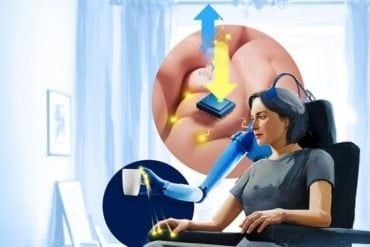Summary: A combination of approved and novel therapeutics improved survival rates and reduced both tumor volume and growth for those suffering from glioblastoma brain cancer.
Source: LSU
A study led by Nicolas Bazan, MD, PhD, Boyd Professor and Director of LSU Health New Orleans Neuroscience Center of Excellence, reports that in an experimental model of glioblastoma multiforme (GBM), a combination of approved and novel therapeutics improved survival and reduced tumor volume and growth.
Results are published online in Frontiers in Pharmacology.
The research team tested three therapeutics, alone and in combination — Avastin, a monoclonal antibody that inhibits the growth of new blood vessels approved in 2008 to treat GBM, LAU-0901, a synthetic molecule that blocks pro-inflammatory platelet-activating factor, and Elovanoids, a novel class of lipid mediators or bioactive chemical messengers that are released in response to cell injury or when cells are confronted with adversities for survival. Dr. Bazan’s lab discovered both LAU-0901 and Elovanoids.
“We have shown here that in combination, LAU-0901/Avastin, ELV/LAU-0901, or ELV/Avastin had a synergistic effect in decreasing tumor growth by 69, 79, and 89%, respectively,” says Bazan. “We concluded that LAU-0901 and ELV combined with Avastin exert a more potent inhibition of glioblastoma multiforme progression than monotherapy. To our knowledge, this is the first study that demonstrates the efficacy of these novel therapeutic regimens in a model of glioblastoma multiforme and may provide the basis for future therapeutics in patients with GBM.”
This new treatment approach targets not only angiogenesis (the formation of new blood vessels) but inflammation and oxidative stress. All three are actively involved in the development and progression of this deadly cancer.
According to the National Cancer Institute, glioblastoma multiforme is a fast-growing type of central nervous system tumor that forms from glial (supportive) tissue of the brain and spinal cord and has cells that look very different from normal cells. Glioblastoma multiforme usually occurs in adults and affects the brain more often than the spinal cord.
Notes co-author Ludmila Belayev, MD, LSU Health New Orleans Professor of Neurosurgery, Neurology and Neuroscience, “Glioblastoma multiforme has a poor prognosis and low survival rate. The current standard of care for GBM is chemotherapy combined with radiation following surgical intervention, altogether with limited efficacy, since survival averages 18 months.”
“The development of effective GBM therapy presents several challenges,” Bazan explains.
“These tumors are not only genetically unstable but can differ among patients and also contain different cancer cells within the same tumor. A multipronged approach that targets key signaling pathways, specifically angiogenesis, inflammation, and oxidative stress pathways, may open new therapeutic avenues. Our results showing that LAU-0901 and ELV increase the effectiveness of Avastin offer a strategy that may ultimately improve clinical outcomes in patients with GBM.”

The research team also included Drs. Valerie A. Cruz Flores, Hemant Menghani, Pranab K. Mukherjee, Luis Marrero, Larissa Khoutorova, Madigan M. Reid, and Ludmila Belayev at LSU Health New Orleans’ Neuroscience Center of Excellence, as well as Drs. Andre Obenaus and Quan Dang at the University of California Irvin, Irvine.
The subject matter of this manuscript is protected by a United States provisional patent application assigned to the Board of Supervisors of Louisiana State University and Agricultural and Mechanical College (LSU) and licensed to a company, NeuResto Therapeutics, founded by co-author Nicolas Bazan, MD, PhD. The remaining authors declare that the research was conducted in the absence of any commercial or financial relationships that could be construed as a potential conflict of interest.
Funding: This research project was supported by Hyundai Hope On Wheels and Resident Research grants from LSU Health New Orleans Pediatrics Hematology-Oncology.
Note: An additional commentary in Cancer and Metastasis Reviews highlights the conceptual advancement and therapeutic implications of these discoveries, and is available here.
About this brain cancer research news
Author: Leslie Capo
Source: LSU
Contact: Leslie Capo – LSU
Image: The image is in the public domain
Original Research: Open access.
“Combined Therapy With Avastin, a PAF Receptor Antagonist and a Lipid Mediator Inhibited Glioblastoma Tumor Growth” by Nicolas Bazan et al. Frontiers in Pharmacology
Abstract
Combined Therapy With Avastin, a PAF Receptor Antagonist and a Lipid Mediator Inhibited Glioblastoma Tumor Growth
Glioblastoma multiforme (GBM) is an aggressive, highly proliferative, invasive brain tumor with a poor prognosis and low survival rate. The current standard of care for GBM is chemotherapy combined with radiation following surgical intervention, altogether with limited efficacy, since survival averages 18 months.
Improvement in treatment outcomes for patients with GBM requires a multifaceted approach due to the dysregulation of numerous signaling pathways. Recently emerging therapies to precisely modulate tumor angiogenesis, inflammation, and oxidative stress are gaining attention as potential options to combat GBM.
Using a mouse model of GBM, this study aims to investigate Avastin (suppressor of vascular endothelial growth factor and anti-angiogenetic treatment), LAU-0901 (a platelet-activating factor receptor antagonist that blocks pro-inflammatory signaling), Elovanoid; ELV, a novel pro-homeostatic lipid mediator that protects neural cell integrity and their combination as an alternative treatment for GBM. Female athymic nude mice were anesthetized with ketamine/xylazine, and luciferase-modified U87MG tumor cells were stereotactically injected into the right striatum.
On post-implantation day 13, mice received one of the following: LAU-0901, ELV, Avastin, and all three compounds in combination. Bioluminescent imaging (BLI) was performed on days 13, 20, and 30 post-implantation. Mice were perfused for ex vivo MRI on day 30.
Bioluminescent intracranial tumor growth percentage was reduced by treatments with LAU-0901 (43%), Avastin (77%), or ELV (86%), individually, by day 30 compared to saline treatment. In combination, LAU-0901/Avastin, ELV/LAU-0901, or ELV/Avastin had a synergistic effect in decreasing tumor growth by 72, 92, and 96%, respectively.
Additionally, tumor reduction was confirmed by MRI on day 30, which shows a decrease in tumor volume by treatments with LAU-0901 (37%), Avastin (67%), or ELV (81.5%), individually, by day 30 compared to saline treatment. In combination, LAU-0901/Avastin, ELV/LAU-0901, or ELV/Avastin had a synergistic effect in decreasing tumor growth by 69, 78.7, and 88.6%, respectively. We concluded that LAU-0901 and ELV combined with Avastin exert a better inhibitive effect in GBM progression than monotherapy.
To our knowledge, this is the first study that demonstrates the efficacy of these novel therapeutic regimens in a model of GBM and may provide the basis for future therapeutics in GBM patients.






